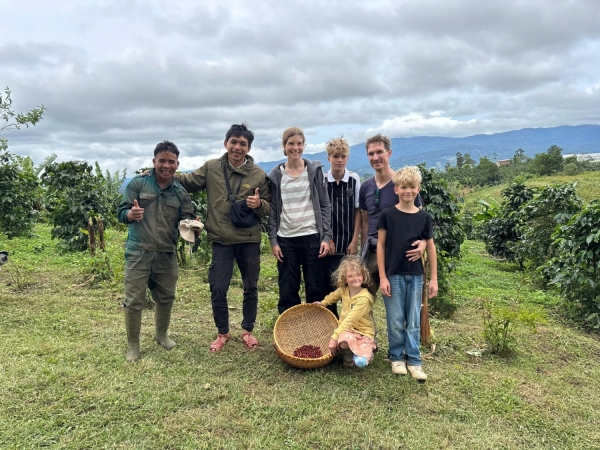
Bài tiếng Việt đã có sẵn tại đây: Hành Trình Cà Phê HuyEco 2024–2025: Biến Động, Lựa Chọn và Cam Kết | HuyEco.vn
From a year of uncertainty to a harvest of resilience
The global coffee industry has just weathered another turbulent year. With prices soaring for a second consecutive season, many farmers abandoned sustainable practices in favor of short-term survival. The fear of crop theft and unpredictable weather pushed some to harvest early—green cherries destined for instant coffee—rather than wait for full ripeness.
At HuyEco, we chose a different path: to stay committed to quality, sustainability, and the people behind every bean.

In 2023, post-COVID, low-grade coffee was still trading at around 35,000 VND/kg. But prices quickly surged past 120,000 VND/kg—and by early 2025, even commercial-grade coffee remained above 130,000 VND/kg.
This price volatility reshaped relationships across the supply chain. For many farmers, the risk of theft and market uncertainty made it difficult to justify the extra effort required for specialty-grade cherries. Even with higher prices, sourcing ripe, high-quality fruit became increasingly difficult.


This year, climate change made itself felt in every corner of the farm. Prolonged droughts led to water shortages and tree loss, while unseasonal rains triggered early flowering—often before irrigation could be applied—causing widespread blossom drop.
At the same time, heavy rains during harvest made drying and fermentation more challenging than ever. Producing high-quality coffee under these conditions required not just skill, but patience and adaptability.

For Robusta, we focused on Natural processing:
This method enhances fruity notes and body—bringing out the best in Robusta, even in a tough year.




For Arabica, thanks to our partner farmers’ dedication to organic practices, we received cherries with 99% ripeness. This allowed us to process efficiently and confidently using the Honey method, which retains the mucilage for added sweetness and complexity—without the need for water fermentation, which can acidify the soil.



With prices fluctuating throughout 2024, we couldn’t rely on a single strategy. We partnered with local suppliers to source high-ripeness commercial coffee at fair prices—ensuring continuity without compromising our values.
We hope 2025 brings more stability, so both farmers and producers can plan with confidence.


Want to taste the story behind the bean? Visit HuyEco Café in Dalat—a space where you can enjoy our coffee, meet the people behind it, and learn about regenerative farming in a cup.
Or join our eco coffee tour to see the process firsthand—from cherry to drying bed to brew.
📍 Book a tour
📍 Visit HuyEco Café
Order HuyEco Coffee
→ Explore and order HuyEco’s original coffee selections.
Eco Coffee Tour
→ Discover our farm tour experience—from cherry to cup.
About HuyEco Farm
→ Learn about our story, values, and the people behind HuyEco.
Why Choose Organic Coffee?
→ A blog post explaining the benefits of organic coffee.
ICO Coffee Market Reports
→ Global coffee price updates from the International Coffee Organization.
Specialty Coffee Association
→ Industry standards and resources for specialty coffee professionals.
Rainforest Alliance – Climate & Coffee
→ Insights into how climate change is affecting coffee production.
FAO – Coffee & Sustainable Agriculture
→ FAO’s resources on sustainable coffee farming practices.
Perfect Daily Grind – Coffee Processing Methods
→ In-depth articles on global coffee processing techniques.
Reader Comments
Newer articles
 Sustainable Coffee & Local Culture Tour in Da Lat — Arabica, Robusta & Ethical Farming
Sustainable Coffee & Local Culture Tour in Da Lat — Arabica, Robusta & Ethical Farming
 Discover Sustainable Coffee in Da Lat — A Farm-to-Cup Journey with HuyEco
Discover Sustainable Coffee in Da Lat — A Farm-to-Cup Journey with HuyEco
 Sustainable Coffee and Local Farming Realities in Da Lat HuyEc
Sustainable Coffee and Local Farming Realities in Da Lat HuyEc
 From Forest to Cup: A Personal Journey into Sustainable Coffee in Da Lat
From Forest to Cup: A Personal Journey into Sustainable Coffee in Da Lat
 Inside HuyEco: How a Coffee Huller Machine Transformed Our Coffee Production
Inside HuyEco: How a Coffee Huller Machine Transformed Our Coffee Production
 From Forest to Cup: A Farmer’s Vision for Sustainable Coffee and Local Travel in Da Lat
From Forest to Cup: A Farmer’s Vision for Sustainable Coffee and Local Travel in Da Lat
 Field Notes from Xã Lát: Rooted in Regenerative Coffee & Indigenous Farming
Field Notes from Xã Lát: Rooted in Regenerative Coffee & Indigenous Farming
 Đưng K'Nớ: Brewing Sustainable Coffee in Vietnam’s Highland Forest
Đưng K'Nớ: Brewing Sustainable Coffee in Vietnam’s Highland Forest
 Living Coffee Ecosystem in Da Lat – HuyEco’s Way of Growing
Living Coffee Ecosystem in Da Lat – HuyEco’s Way of Growing
 Nel Drip & Wabi-Sabi: Japanese Coffee Rituals at HuyEco Da Lat
Nel Drip & Wabi-Sabi: Japanese Coffee Rituals at HuyEco Da Lat